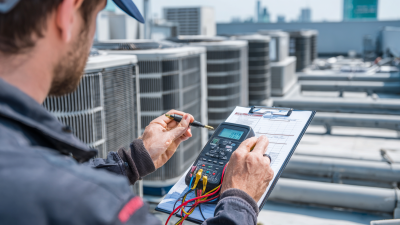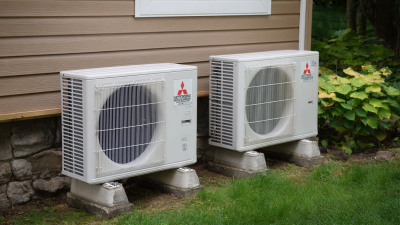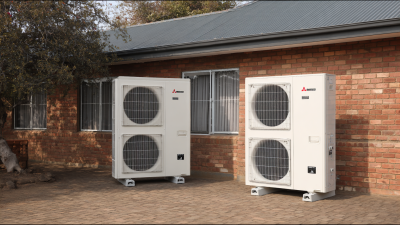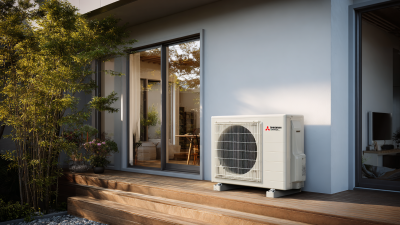Discover How Ductless Heat and Air Systems Revolutionize Home Comfort and Efficiency
 In recent years, ductless heat and air systems have emerged as a transformative solution for home comfort and energy efficiency. According to a report by the U.S. Department of Energy, ductless systems can enhance energy efficiency by up to 30% when compared to traditional heating and cooling methods. This is particularly significant as homeowners face increasing energy costs and seek sustainable living options.
The flexibility in installation and zoning capabilities of ductless heat and air units allows for targeted heating and cooling, ensuring that each room can be customized to individual comfort levels without the energy waste associated with ductwork.
Additionally, the Environmental Protection Agency highlights that these systems can significantly reduce greenhouse gas emissions, further emphasizing their role in promoting an eco-friendly lifestyle.
As the demand for efficient and effective climate control grows, ductless heat and air systems stand out as a revolutionary choice for modern households.
In recent years, ductless heat and air systems have emerged as a transformative solution for home comfort and energy efficiency. According to a report by the U.S. Department of Energy, ductless systems can enhance energy efficiency by up to 30% when compared to traditional heating and cooling methods. This is particularly significant as homeowners face increasing energy costs and seek sustainable living options.
The flexibility in installation and zoning capabilities of ductless heat and air units allows for targeted heating and cooling, ensuring that each room can be customized to individual comfort levels without the energy waste associated with ductwork.
Additionally, the Environmental Protection Agency highlights that these systems can significantly reduce greenhouse gas emissions, further emphasizing their role in promoting an eco-friendly lifestyle.
As the demand for efficient and effective climate control grows, ductless heat and air systems stand out as a revolutionary choice for modern households.
The Benefits of Ductless Heat and Air Systems for Modern Homes
Ductless heat and air systems are changing the landscape of home comfort and energy efficiency. Modern homes are increasingly benefiting from the flexibility and convenience that these systems offer. Unlike traditional HVAC systems, ductless units can provide both heating and cooling without the need for extensive ductwork. This makes them ideal for retrofitting older homes or adding climate control to new spaces. Homeowners can enjoy personalized comfort in individual rooms or zones, making temperature control more efficient and tailored to family needs.
**Tips for Choosing Ductless Systems:** When selecting a ductless heat and air system, consider the size of your space and the necessary capacity for heating and cooling. Consulting with an HVAC professional can help determine the optimal placement of units for maximum efficiency. Additionally, look for energy-efficient models with high SEER and HSPF ratings to ensure lower utility bills.
Moreover, ductless systems often come with advanced technology features, such as smart thermostats and remote controls, which enhance convenience. Regular maintenance, such as cleaning the indoor and outdoor units, will ensure your system runs efficiently and prolong its lifespan. With these benefits, it’s clear why ductless systems are becoming a popular choice for modern homeowners seeking comfort and efficiency.
Discover How Ductless Heat and Air Systems Revolutionize Home Comfort and Efficiency
| Benefit | Description | Impact on Home | Efficiency Rating |
|---|---|---|---|
| Energy Efficiency | Ductless systems use less energy compared to traditional HVAC systems. | Lower energy bills and reduced carbon footprint. | SEER Ratings 16-26 |
| Flexibility | Allows for zoned heating and cooling in different rooms. | Increased comfort tailored to individual preferences. | N/A |
| Easy Installation | No ductwork is required, leading to quicker setup. | Reduces renovation time and cost. | N/A |
| Improved Indoor Air Quality | Filters allergens and pollutants effectively. | Healthier living environment. | N/A |
| Aesthetics | Indoor units are sleek and unobtrusive. | Enhances the overall decor of the home. | N/A |
Understanding the Energy Efficiency Ratings of Ductless Systems
Ductless heat and air systems have emerged as a transformative solution for homeowners seeking comfort and energy efficiency. One crucial aspect of these systems is their energy efficiency ratings, often measured by Seasonal Energy Efficiency Ratio (SEER) or Heating Seasonal Performance Factor (HSPF). According to the American Council for an Energy-Efficient Economy (ACEEE), systems with a SEER rating of 16 or higher can significantly reduce energy costs, averaging savings of up to 30% compared to traditional HVAC systems. This efficiency not only leads to lower utility bills but also minimizes environmental impact, making ductless systems a smart choice for eco-conscious homeowners.
When selecting a ductless system, it is essential to consider energy efficiency ratings carefully. Focus on models that meet or exceed the ENERGY STAR® criteria, which represent the top 25% of energy-efficient products on the market. This can ensure optimal performance while contributing to substantial long-term savings.
Tips: Always consult with a certified HVAC professional to assess your home’s specific needs, as they can recommend the ideal ductless system based on size and required capacity. Additionally, regular maintenance, such as cleaning the filters and scheduling annual tune-ups, can help maintain efficiency and prolong the lifespan of your system. Investing in smart thermostats can also enhance energy management, allowing homeowners to optimize heating and cooling patterns effectively.
Comparing Installation Costs: Ductless Systems vs. Traditional HVAC
When considering home heating and cooling solutions, installation costs play a significant role in decision-making. Ductless heat and air systems, also known as mini-splits, can initially appear more expensive than traditional HVAC systems. However, the long-term efficiency and energy savings can offset that initial investment. Ductless systems only require a small hole for the line set, making installation less invasive and often cheaper overall. On the other hand, traditional HVAC systems typically require extensive ductwork, which can lead to higher installation and maintenance costs.
**Tip:** When comparing options, always request detailed quotes that include both the installation costs and potential energy savings over time. This will give you a clearer picture of the overall value each system provides.
Moreover, ductless systems offer the advantage of zoning, allowing homeowners to control the temperature in different areas of the home independently. This not only enhances comfort but also contributes to energy efficiency, as you only heat or cool the spaces you’re using. Traditional systems often lack this flexibility, leading to energy waste in unoccupied rooms.
**Tip:** Consider the layout of your home and your family’s lifestyle when deciding between systems. A tailored approach could lead to multiple benefits, from enhanced comfort to lower utility bills.
Comparing Installation Costs of Ductless Systems vs. Traditional HVAC
This chart illustrates the estimated installation costs for ductless heating and air systems compared to traditional HVAC systems. Ductless systems generally have a lower installation cost, providing an efficient alternative for home comfort.
How Ductless Systems Improve Indoor Air Quality and Comfort
 Ductless heat and air systems, also known as mini-split systems, are transforming the way we think about indoor air quality and comfort. Unlike traditional forced air systems that rely on ducts to distribute heated or cooled air, ductless systems deliver air directly into individual rooms. This targeted approach not only enhances comfort by allowing customizable temperature control in different areas of the home but also minimizes the risk of dust, allergens, and other pollutants circulating through ductwork. As a result, homeowners can enjoy a cleaner, healthier living environment.
Ductless heat and air systems, also known as mini-split systems, are transforming the way we think about indoor air quality and comfort. Unlike traditional forced air systems that rely on ducts to distribute heated or cooled air, ductless systems deliver air directly into individual rooms. This targeted approach not only enhances comfort by allowing customizable temperature control in different areas of the home but also minimizes the risk of dust, allergens, and other pollutants circulating through ductwork. As a result, homeowners can enjoy a cleaner, healthier living environment.
Moreover, ductless systems are engineered to promote better indoor air quality. Many units include advanced filtration systems that capture dust, pollen, and other irritants, ensuring that the air we breathe is fresher and safer. These filters can be easily maintained or replaced, which further improves the air quality over time. With the added benefit of energy efficiency, ductless systems can help reduce energy consumption while maintaining optimal comfort levels, making them an excellent choice for environmentally conscious homeowners seeking to enhance their indoor environment.
The Role of Smart Technology in Enhancing Ductless System Performance
Smart technology plays a pivotal role in enhancing the performance of ductless heat and air systems, making them more efficient and user-friendly than ever before. These innovative systems, equipped with advanced sensors and intelligent controls, allow homeowners to optimize their indoor climate with ease. For instance, smart thermostats can learn a household's schedule and preferences, adjusting temperatures automatically to ensure comfort while minimizing energy consumption. This level of automation not only provides personalized comfort but also significantly reduces utility bills.
Moreover, the integration of smart technology facilitates remote monitoring and control, empowering homeowners to manage their ductless systems from anywhere via smartphone apps. This capability means adjustments can be made on-the-go, ensuring that homes are always at an ideal temperature upon arrival. Furthermore, many systems now offer diagnostic features, alerting users to potential issues before they escalate, thereby prolonging the lifespan of the units. Overall, the fusion of smart technology with ductless heating and cooling systems marks a significant advancement in home comfort and energy efficiency.

Related Posts
-

How Split Heating and Cooling Systems Enhance Home Comfort Year Round
-

Maximize Your Comfort: The Ultimate Guide to Expert AC Tune-Ups You Can't Miss!
-

Exploring the Efficiency of Ductless Heating and Cooling Units: A Comprehensive Guide to Energy Savings and Comfort
-

Maximize Your AC Efficiency with Expert Tune Up Service for Comfortable Living
-

Understanding the Benefits of Split Heating and Cooling Systems for Home Comfort
-

Discover How Ductless Heat Pumps Can Transform Your Home's Energy Efficiency